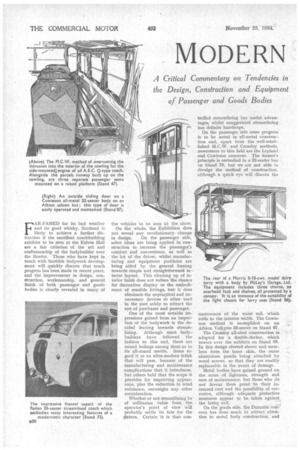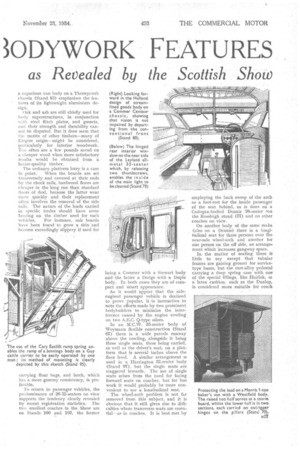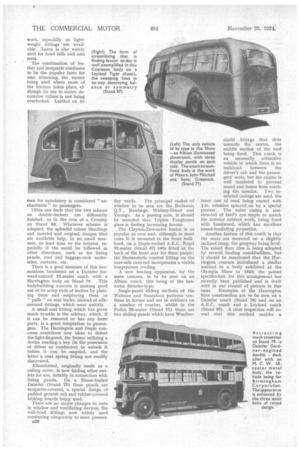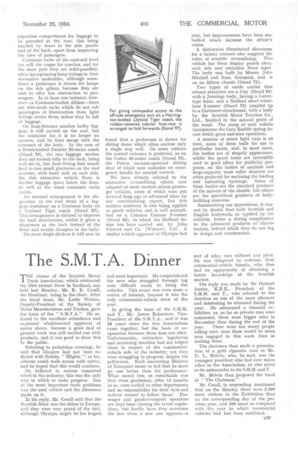MODERN BODYWORK FEATURES
Page 40

Page 41

Page 42

Page 43

If you've noticed an error in this article please click here to report it so we can fix it.
as Revealed by the Scottish Show
FAR-FAMED for its bad weather and its good whisky, Scotland is likely to achieve a further distinction if the excellent coachbuilding exhibits to be seen at the Kelvin Hall are a fair criterion of the art and craftsmanship of the bodybuilder over the Border. Those who have kept in touch with Scottish bodywork development will quickly discern that much progress has been made in recent years, and the improvement in design, construction, workmanship, and general finish of both passenger and goods bodies is clearly revealed in many of
the vehicles to be seen at the show. On the whole, the Exhibition does not reveal any revolutionary change in design. On the passenger side, sober ideas are being applied in construction to increase the passenger's comfort and convenience, as well as the lot of the driver, whilst manufacturing and equipment problems are being aided by the general leaning towards simple and straightforward interior layout. This cleaning up of interior finish does not reduce the chance for decorative display or the embodiment of sensible fittings, but it does eliminate the unpractical and unnecessary devices so often used in the past solely to attract the eye of purchaser and passenger.
One of the most notable impressions gained from an inspection of the bodywork is the decided leaning towards Streamlining. Although most bodybuilders have followed the fashion to this end, there are mixed feelings among them as to its all-round merits. Some regard it as an ultra-modern fetish that will pass, because of the manufacturing and maintenance complications that it introduces, but others hold that the scope it provides for improving appearance, plus the reduction in wind resistance, outweighs any other consideration.
Whether or not streamlining he of utilitarian value from the operator's point of view will probably settle its fate for the future. Certain It is that con
trolled streamlining has useful advantages, whilst exaggerated streamlining has definite handicaps.
On the passenger side some progress is to be noted in all-metal construction and, apart from the well-established M.C.W. and Crossley methods, newcomers to this field are the Leyland and Cowieson concerns, The former's principle is embodied in a 32-seater bus on Stand 78, but we are not able to divulge the method of construction, al:though a quick eye will discern the narrowness of the waist rail, which adds to the interior width. The Cowieson method is exemplified on an Albion Valkyrie 22-seater on Stand 87.
The Crossley all-steel construction is adopted for a double-decker, which towers over the exhibits on Stand 68. In this design riveted sheets and members form the inner skin, the outer aluminium panels being attached by wood screws, so that they are readily replaceable in the event of damage.
Metal bodies have gained ground on the score of lightness, strength and ease of maintenance, but those who do not favour them point to their increased cost and the possibility of corrosion, although adequate protective measures appear to be taken against the latter evil.
On the goods side, the Duramin concern has done much to attract attention to metal body construction, and a capacious van body on a Thornycroft chassis (Stand 82) emphasizes the features of its lightweight aluminium design.
Oak and ash are stilt chiefly used for body superstructures, in conjunction with steel flitch plates, and gussets, and their strength and durability cannot be disputed. But it does seem that the merits of other timbers—many of Empire origin—might be .considered, particularly for interior woodwork. Too often are a few pounds saved on a cheaper wood when more satisfactory results would he obtained from a better-quality timber.
The ordinary platform lorry is a case in point. When the hoards are set transversely and covered at their ends by the chock rails, hardwood floors are cheaper in the long run than standard floors of deal, because the latter wear more quickly and their replacement often involves the removal of the side rails. Th6 nature of the loads carried in specific trades should have some hearing on the timber used for such vehicles. For instance, oak boards have been found to grow a skin and become exceedingly slippery if used for being a Commer with a Stewart body and the latter a Dodge with a Duple body. In both cases they are of compact and smart appearance.
As it would appear that the sideengined passenger vehicle is destined to prove popular, it is instructive to note the efforts made by two prominent bodybuilders to minimize the interference caused by the engine cowling on two A.E.C. Q-type oilers.
In an M.C.W. 35-seater body of Weyrnann flexible construction (Stand 67) there is a wide parcels runway above the cowling, alongside it being three single seats, these being carried, as well as the driver's seat, on a platform that is several inches above the floor level. A similar arrangement is used in a Harrington 22-seater body (Stand f)7), but the single seats are staggered inwards. The use of single seats arises from the need for facing forward seats on coaches, but for bus work it would probably be more convenient to use a longitudinal seat.
• The wheel-arch problem is not far removed from this subject, and it is obvious that it still gives rise to difficulties where transverse seats are essential—as in coaches. It is best met by
employing the back sweep of the arch as a foot-rest for the inside passenger of the seat behind, as is done on a Cadogan-bodied Dennis 26-seater .4on. the Rossleigh stand (77) and on other coaches on view.
On another body of the same make (also on a Dennis) there is a longitudinal seat for three persons over The near-side wheel-arch and another for one person on the off side, an arrangement which increases gangway space.
In the matter of seating there is little to say except that tubular frames are gaining ground for servicetype buses, but the cast-alloy pedestal carrying a deep spring case with one of the special fillings, like Hairlok, os a latex cushion, such as the Dunlop, is considered more suitable for coach own for upholstery is considered " uncharitable " to passengers.
Often one finds that the two saloons on double-deckers are differently finished, as in the case of a Crossley on Stand 68. Whatever scheme is adopted, the splendid colour blendings and tasteful and original designs that are available help, in no small measure, to lend tone to the interior, especially if the motif be followed in other directions, such as for lining panels, roof and luggage-rack undersides, curtains, etc.
There is a good instance of this harmonious treatment on a Daimler forward-control 32-seater coach with a Harrington body on Stand 79. This bodybuilding concern is making good use of its scrap ends of leather by plaiting them and employing them as " pilliq " on seat backs, instead of silkcovered fittings, which wear quickly.
A small seat fitting which has given much trouble is the ashtray, which, if it can be removed or has any loose . parts, is a great temptation to passengers. The Harrington and Duple Concerns contribute new ideas to defeat the light-fingered, the former utilizing a device needing a key (in the possession of driver or conductor) to unlock it before it can be emptied, and the latter a neat spring fitting not readily discovered.
Alhambrinal, originally made as a ceiling cover, is now finding other outlets for use, notably in connection with lining panels. On a Brush-bodied Daimler (Stand 79) these panels are moquette-covered, a special design of padded garnish rail and rubber-covered kitking boards being used.
There are no major changes to note in window and ventilating devices, the well-tried fittings now widely used continuing adequately to meet present 1328 day needs. The principal makes of window to be seen are the Beclawat, Q.T., Rawlings, Widney-Stuart and Yoangs. As a passing note, it should be recorded that Triplex Toughened glass is finding increasing favour.
The Clayton-Dewandre heater is as popular as ever and, although in most cases it is mounted in the front bulk head, on a Duple-bodied A.E.C. Regal 32-seater (Stand 67) tbris fitted at the back of the front seat for three people; the thermostatic control fitting on the near-side cant-rail incorporates a visible temperature reading.
A new heating apparatus, by the same concern, is to be seen on an Albion coach, this being of the hotwater diverter-type.
Single-panel sliding sections of the Walrnan and Sunsaloon patterns continue in favour and are in evidence on a number of coaches, whilSt in the Foden 26-seater (Stand 73) there are two sliding panels which have Weather shield fittings that slide towards the centre, the middle section of the roof being fixed. This coach is• an unusually attractive vehicle in which there is no bulkhead between the driver's cab and the passengers' seats, but the engine is well insulated to prevent sound and fumes from reaching the interior. Two insulated casings are used, the inner one of steel being coated with On. asbestos sprayed on by a special process. The outer casing is constructed of bird's eye maple to match the interior cabinet .work, being lined with Insulwood, which has excellent sound-insulating properties.
Another feature of this coach is that the seats are mounted on a slightly inclined ramp, the gangway being level. The raised floor idea is being adopted by several leading coachbuilders, but it should be mentioned that the Harrington concern introduced a similar method in a body exhibited at the Olympia Show in 1933; the patent specification for this arrangement has recently been published and is dealt with in our resume of patents in this issue. Examples of the Harrington floor construction are to be seen on a Daimler coach (Stand 79) and on an A.E.C. coach and a Leyland coach (Stand 97). A close inspection will reveal that this method enables a
capacious compartment for luggage to be providedat the rear; this being reached by doors in the side panels and at the back, apart from improving the view of passengers.
Container racks at the cant-rail level are still the vogue for coaches, and for the *most part they are solid-panelled, often incorporating lamp fittings in their decorative undersides, although sometimes a preference is shown for lamps on the side pillars, because they are said to offer less obstruction to passengers. In at least one instance, however—a Cowieson-bodied Albion—there are wire-mesh racks which do not rob' passengers of illumination from light fittings above them, unless they be full of luggage.
On long-distance coaches bulky luggage is still carried on the roof, but the container for it is no longer an eyesore, and its lines merge with the contours of the body. In the case of a Brush-bodied Daimler 32-seater coach (Stand 79), the rear luggage section does not extend fully to the back, being well set in, but flush-fitting foot treads lead to two small platforms on the roof contour, with hand rails on each side. On this attractive vehicle there is further luggage space below the floor, as well as the usual container racks inside.
An unusual arrangement is the disposition at the roof front of a luggage container on a Cowieson body on a Leyland Tiger coach (Stand 87). This arrangement is claimed to improve the load distribution, whilst it gives a slipstream at the back instead of the front and avoids draughts in the body.
On most single-deckers it will now be found that a preference is shown for sliding doors which often enclose only a single step well. On some vehicles the central entrance is preferred, as on the Foden 30-seater coach (Stand 73), the Peters vacuum-operated sliding door of which now embodies an emergency handle for manual control.
We have already referred to the attractive streamlining effects now adopted on most modem saloon passenger vehicles, some of which were put forward long ago as advanced ideas by our coachbuilding expert, but this modern tendency is also being applied to goods vehicles, and is well exemplified on a Commer Centaur 2-tonner (Stand 80), in which the Holland design has been carried out by John Stewart and Co. (Wishaw) , Ltd. A similar vehicle appeared at Olympia last year, but improvements have been embodied which increase the driver's vision.
A distinctive illuminated showroom for a bakery concern also suggests the value of sensible streamlining. This vehicle has three display panels along each side and embodies Neon signs The body was built by Messrs. John Mitchell and Sons, Greenock, and is on an Albion chassis (Stand 71).
Two types of cattle carrier that attract attention area Guy (Stand 95) with a Jennings body, having a Lutontype front, and a Bedford short-wheelbase 3-tonner (Stand 72) coupled up to a Cazrimore attachment, with a body by the Scottish Motor Traction Co., Ltd., finished in the natural grain of the wood. The ramp of each vehicle incorporates the Cary F.asilift spring device which gives one-man operation, A number of smart light vans is on view, some of them built for use in particular trades, and, in most cases, the bodies are of shapely appearance, whilst the panel areas are invariably used to good effect for publicity purposes; on the bodies of medium and large-capacity vans roller shutters are often preferred for enclosing the loading and unloading openings. Some of these bodies are the standard products of the makers of the chassis, but others are the specialized products of bodybuilding concerns. Summarizing our impressions, it cannot be denied that both Scottish and English bodywork, as typified by the exhibits, forms a fitting complement to the advanced products of 'chassis makers, behind which they do not lag in design and construction.




























































































